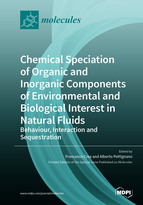Chemical Speciation of Organic and Inorganic components of Environmental and Biological Interest in Natural Fluids: Behaviour, Interaction and Sequestration
A special issue of Molecules (ISSN 1420-3049). This special issue belongs to the section "Analytical Chemistry".
Deadline for manuscript submissions: closed (15 October 2019) | Viewed by 47556
Special Issue Editors
Interests: speciation of polyelectrolytes; acid-base properties and complexing ability towards different classes of organic and inorganic ligands; modelling in HPLC; modelling of separation of linear and branched polyamines by IC chromatography; speciation of UO22+ in different ionic media; interaction with carboxylic acids at low molecular weight and formation of hydrolytic hetero-metal species; determination of the solubility and activity coefficients of different classes of organic ligands in different ionic media
Special Issues, Collections and Topics in MDPI journals
Interests: speciation of ligands of biological and environmental interest; acid-base properties and complexation ability of natural and synthetic polyelectrolytes; removal/recovery of toxic or precious metals by means of biocompatible materials; electrochemical techniques; spectroscopic techniques; calorimetric techniques
Special Issue Information
Dear Colleagues,
The chemical speciation of elements in natural waters and biological fluids is a key topic, essential for discussing the chemical reactivity of constituents in these systems. It is well understood that it is the chemical form of a metal or metalloids that conditions its reactivity, life time and fate in the environment. The chemical speciation is also important from a geochemical and toxicological point of view, since it gives essential information on the geochemical behavior of chemical species and on the biological availability and toxicity of elements. The knowledge of speciation is critical to understand the transport, accumulation, bioavailability and toxicity of elements within and between the environmental compartments of air, soil, water, sediments and biota.
We invite researchers to contribute with original articles or reviews that can give an update on the knowledge of chemical speciation of the main and trace organic and inorganic components of natural waters and biological fluids. Potential topics include:
- Papers that lead with chemical speciation or coordination chemistry of organic and inorganic components in aqueous solutions;
- Study of interactions of metals and ligands in aqueous solution simulating the composition of the natural waters, and determination of the thermodynamic aqueous parameters;
- Speciation analysis with new hyphenated techniques;
- Sequestration or removal of pollutants and potential remediation techniques.
Prof. Dr. Francesco Crea
Prof. Dr. Alberto Pettignano
Guest Editor
Manuscript Submission Information
Manuscripts should be submitted online at www.mdpi.com by registering and logging in to this website. Once you are registered, click here to go to the submission form. Manuscripts can be submitted until the deadline. All submissions that pass pre-check are peer-reviewed. Accepted papers will be published continuously in the journal (as soon as accepted) and will be listed together on the special issue website. Research articles, review articles as well as short communications are invited. For planned papers, a title and short abstract (about 100 words) can be sent to the Editorial Office for announcement on this website.
Submitted manuscripts should not have been published previously, nor be under consideration for publication elsewhere (except conference proceedings papers). All manuscripts are thoroughly refereed through a single-blind peer-review process. A guide for authors and other relevant information for submission of manuscripts is available on the Instructions for Authors page. Molecules is an international peer-reviewed open access semimonthly journal published by MDPI.
Please visit the Instructions for Authors page before submitting a manuscript. The Article Processing Charge (APC) for publication in this open access journal is 2700 CHF (Swiss Francs). Submitted papers should be well formatted and use good English. Authors may use MDPI's English editing service prior to publication or during author revisions.
Keywords
- speciation analysis
- sequestration ability
- equilibrium constants
- ligand classes
- models
- natural fluids
- sediments
- soils








